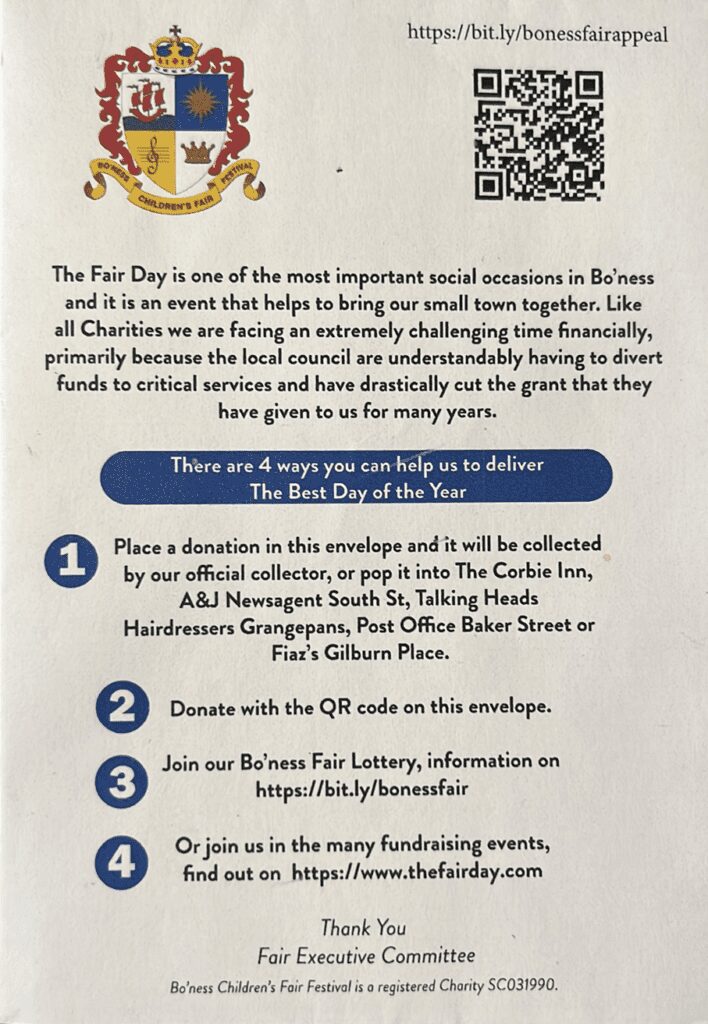“ELIZABETH SNEDDON, youngest daughter of Mr. and Mrs. Wiliam Sneddon, James Place, has been by the popular vote of the senior pupils of Kinneil School, appointed school Queen.”
So announced the ” Linlithgowshire Gazette ” on Friday, 28th May, 1920.
After four years of war the Fair had been revived in July, 1919, and in 1920 there was tremendous enthusiasm in the town to make the second post-war Fair even more successful than the first. Would it be possible to reintroduce the school caps, which had been such a colourful feature of the Fairs before the war, but which had not been available in 1919 due to post-war shortages? Would there be enough material to allow the fairies, who had been absent from the 1919 Fair, to return to the scene? These were tow of the questions discussed at length at the Fair Committee meetings. Other matters hotly debated that year seem strangely reminiscent of those of the present day. There were difficulties over catering, while Councillor Angus Livngston was vigorously campaigning for a shorter route. In the end it was agreed to keep the same route as the previous year with the procession going round the town, along Corbiehall and up the Snab Brae to Ladywell Park, with the coronation ceremony taking place there after the procession.
By the summer of 1920 most of the menfolk of Bo’ness had returned from the army and as May gave way to June the Fair Committee urged them to build arches all along the procession route. Many of them certainly had plenty of time to do so, for strikes were widespread in the town as the former soldiers discovered that the brave new world which they had fought for was not so wonderful after all. In the pits especially there was a great deal of unrest as British coal fought to regain markets lost during the war. One group of Bo’ness miners from the Cadells’ pits were in fact to miss the Fair of 1920 as they spent the whole summer hundreds of miles from home far beyond the Artic Circle in Spitsbergen, trying to find new cheap source of coal for the Scottish Spitsbergen Syndicate.
In Bo’ness, one group of workers for whom there was more than ample work were shipbreakers, and with the battleship H.M.S Exmouth a cruiser, a whole fleet of submarines and many smaller naval vessels all redundant after the war, queuing to be scrapped at Bridgeness and Carriden, one colourful side effect as far as the Fair was concerned was the abundance of ships, bunting and signal flags available to decorate the whole town.
Even the front of the stage in the Town Hall was bedecked with flags for the Academy end of term prize-giving at which Margaret Park received the Stewart Gold Medal, Louisa Begg the Stewart Silver Medal, Howard L. Pritchard the prize as dux of the 5th year and Mary Baptie the prize as dux of the 4th year. Earlier the audience had been entertained to a performance of “The Tempest”, in which leading roles were played by Helen McLellan and Betty Watt.
As the audience of parents and friends left the Town Hall many of them must have wondered if the Academy’s stage effects for “The Tempest” had not been a bit too realistic for they were met by a downpour of rain and a cold wind blowing up form the river, which made it feel more like November than July. Rain had in fact been the main feature of the weather since the month began and when it was still wet the following morning even those in Bo’ness who steadfastly believed the local tradition that the Fair always got the same weather as Linlithgow Marches, must have begun to doubt if they could really hope for the brilliant sunshine which their neighbours across the hill had enjoyed in June.
Friday, 16th July, 1920, did however dawn fair, and by the time that the children began to gather at their schools to receive their buns and bananas the sun was shining. By eleven o’clock the procession was ready marshalled at the East Partings and as the old Town Clock chimed out the hour it moved off along South Street.
” The thing I remember most,” recalls the Chief Lady in Waiting at the Fair of fifty years ago, Annie Queenan, now Mrs Pettigrew of Philpingstone Road, “were the crowds who lined the route.” And the crowds were certainly not disappointed, for the 1920 procession showed no sign of the post-war shortages which had affected the 1919 Fair. Back were the open landaus, which had not been available the previous year due to a shortage of horses. Back were the traditional schoolcaps. the red, white and blue ones worn by the Kinneil pupils, both boys and girls, receiving special cheers from the crowds. And back, too, were the fairies, and in addition there was the extra spectacle of the little “May Blossoms”.
Especially popular with the crowds was Grange School’s contribution to the procession, “Little Bo Peep”, for young Helen Pow had a real live sheep to look after as she rode through the streets on the horse-drawn float designed and decorated by Topping Neilson of Bo’ness Co-operative Society. Other presentees that year included “Gypsy Boy and Girl” from the Public, “Japanese Lady and Gentleman” from St Mary’s, “Powder Puff and Jester” from Kinneil, “Cinderella” from the infant school in South Street, “Scots Guard Officer in Full Regimentals” from Borrowstoun, “Bubbles and Dolly Varden” from Carriden, and “Bonnie Prince Charlie and Flora MacDonald” from Blackness.
Out past the merry-go-rounds and side stalls in Corbiehall the procession, led by Bo’ness Pipe Band, made its way west with the fact that it was a Kinneil Fair becoming ever clearer with the decorations increasing steadily until that year’s highlight, the great arch at the Snab, was finally reached. Built by the miners at Kinneil Pit, it was said to be the finest arch ever seen in the town and certainly, with its main span surmounted by a crown and two smaller arches across the pavements, it was one of the largest seen up until that time.
The steep brae from the Snab up to the Ladywell Park produced a slight hitch in the proceedings when the driver in charge of Ballantine’s Grange Foundry Float decided that his horse was too warm to tackle the hill without a rest. The short pause was equally welcomed by the human participants in the procession who were refreshed by the inhabitants of the miners rows who quickly fetched pitchers of water for the children and perhaps something slightly stronger for the bandsmen, form their spick and span homes which were freshly painted and whitewashed for the occasion.
Once the procession was under way again it did not take it long to reach the park where Mrs Gladstone, wife of the late rector of the Academy, was waiting to crown the Queen. According to the “Gazette’s reporter, Queen Elizabeth was “a tall fine complexioned girl who carried her honours with regal dignity and who looked lovely in a three-quarters length dress of cream crepe de chene.”
“Never has the park held such a vast thong and never has the crowning ceremony been so varied and rich in colour. The sun shone as Queen Elizabeth received all the young presentees, but just as the stage was cleared a sinister change took place in the weather and soon the first drops of rain were felt.”
The “Gazette” report goes on to describe how the Queen and her retinue were rushed to shelter in Kinneil House, house the maypole dancers defied the weather and how the bands played on, but most of the spectators soon set off home to enjoy the traditional Fair meal of steak pie. For many Bo’ness families that year steak pie was something of a luxury, because meat prices had recently soared to such unprecedented heights that an emergency meeting under the chairmanship of Mr. Robert Baptie had been held in the town only a week before, as a result of which the local butchers, led by Mr. McMinn, had accused the Scottish farmers of outright profiteering. In July, 1920, one butcher’s shop in South Street was selling, for the first time, imported frozen meat at much lower prices, but it was looked upon with deep suspicion and was certainly not considered good enough to be included in the Fair steak pies.
In the evening the rain continued to fall, no doubt encouraging many to go to the pictures rather than the shows. Mr. Jeffrey’s “Picture House” was considered to have a very strong bill with Charlie Chaplin in “His Regeneration” and episode seven of “Lightning Bryce”, but the following week Louis Dickson’s rival establishment was expected to draw the crowds when it presented the Fair Film, produced and directed by Mr. Dickson himself.
For those who preferred to spend the evening in the Anchor Tavern, or one of the many other local pubs, there was little chance of the Fair night becoming the drunken orgy of Victorian times, because closing time was at 9 p.m. prompt, and next day there was further disappointment when, at the very last minute, the local publicans all decided not to take up the Bo’ness magistrates’ offer to allow them to open specially from noon until four o’clock in addition to the usual six till nine opening.
On that Saturday in any case many Bo’nessains left the town, 369 travelling by train to Edinburgh and 142 to Glasgow, while Mr Boyd’s two new open-topped charabancs both carried full compliments to Loch Lomond. Apart from the day trippers, the boys scouts of St. Andrews Church, under scoutmaster McIntosh and the Craigmaillen scouts , under Mr. Richard Shennan, set out for their annual camp at Longniddry, and several local families departed to enjoy a week at the seaside at Rothesay, North Berwick and Arbroath. As they relaxed in their deck chairs perhaps some of the grown ups read copies of Fred Sleath’s newly published book, “Breaker of Ships”. Unlike his two earlier successful work which were both thrillers, this was a novel set in “a small Scottish seaport town”, and for Bo’nessians there was the added interest of trying to identify their friends and neighbours among the characters.
Reading Mr. Sleath’s new book would certainly have provided some light relief from the contents of the daily papers which were full of stories about the terrible troubles in Ireland, events in Russia and letters to the editor complaining about new silver coins which were about to be introduced and suggesting that British Summer Time, introduced as a war measure, should be abandoned.
Somehow things do not seem to have changed all that much since Queen Elizabeth from Kinneil School was crowned fifty years ago, but let’s hope at least that the weather will be better when another Kinneil School Lassie is crowned Queen of this year’s Fair on Friday, 3rd July.
UNKNOWN






